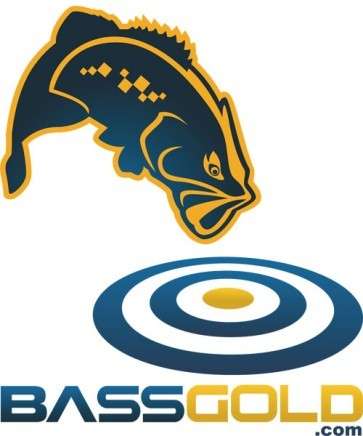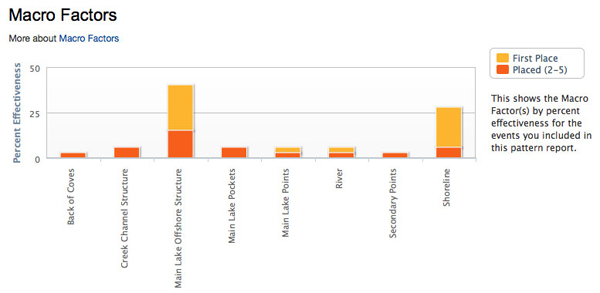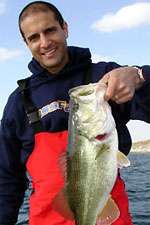
This week, the Elite Series pros will be fishing Tennessee’s Douglas Lake, the second consecutive upland reservoir on the schedule. Even though B.A.S.S. has held only two tournaments on Douglas in the last 10 years, the fact that the lake is an upland reservoir is good for all the Elites, whether they did well on Bull Shoals or not – and whether they fished the Table Rock Central Open or not – because upland reservoirs tend to fish eerily similar to one another.
In fact, for that reason former B.A.S.S. pro and hall of famer Ken Cook would like BassGold.com to be able to search by water type across states, not just within states. This eventually will be possible.
But right now we’re focusing on Douglas, and when you look at the pattern info compiled in a BassGold “Pattern Report” for that lake this time of year, you basically see one thing: offshore cranking.
Couple that with the fact that upland reservoirs are strong pattern lakes – meaning if you find a good pattern, you can replicate it elsewhere – means that pattern is a good starting point. But it’s not always that simple, as the Bull Shoals event showed us.
For Bull Shoals, the historical pattern info in BassGold overwhelmingly pointed at fishing shallow wood to finish in the top five. But you had to bear in mind a couple things: Elite fishermen typically do things a bit differently than even the best local sticks, and the conditions.
The water at Bull Shoals had dropped 8 feet over the couple weeks before the tournament, so that changed things considerably. The X factor also was the spawn: Most people though Bull Shoals was ahead spawn-wise because of the mild winter, but in fact winner Brandon Palaniuk and other top finishers caught prespawners.
The bottom line is the fish would likely have been in shallow wood had the lake level been higher or steadier, so you have to adjust your pattern accordingly.
Macro Factors
Even though good patterns for Douglas point offshore, BassGold shows a pretty even split between “Main Lake Offshore Structure” and “Shoreline” for winning macro factors – though offshore structure dominates in second-fifth finishes.
That could mean winners combine both deep and shallow fish, but Ken said, “With the weather and date considered, I’d put most of my efforts into offshore structure for the win. You might scratch out a top 12 in shallow water, but not a win.”
The Macro Factors graph also shows that related areas – creek channel structure, main lake and secondary points, pockets and coves – factored in high finishes. But as you can see from the graph, winners have only fished offshore structure, points, the shoreline and up the river.

Habitat Factors
As Ken noted, “It’s a pretty even split between rock and wood, but winners seem to be more on rock. On this lake that means structure. If a rocky hump has wood, so much the better, but I would discount shallow wood.”
Oddly, the graph shows wood much more important for winning, with rock more important for second-fifth finishers. What you personally make of this from a fishing standpoint depends on your fishing knowledge and experience.
Lures/Baits
Eastern Tennessee is cranking country, so it’s no surprise that BassGold shows crankbaits factor in about a third of top finishes. Actually, the surprise may be that cranks aren’t even more of a factor in more top finishes this time of year.
But when you add in other deep baits – Carolina rigged lizards, spoons and even, as BassGold’s tournament details show, deep jigging – it basically boils down to fishing deep!
Ken said, “Since it’s fishing offshore, crankbaits will play for the win. It’s a good bet that other offshore lure types will work – I wouldn’t overlook swimbaits, spoons and football jigs as possible backups – but main catchers most likely will be deep cranks.
“If you want to fish shallow, then by all means look up-lake for off-color water with wood cover where there may be a shad spawn going on. Willowleaf spinnerbaits, fluke-type baits and swimbaits work in this scenario. I feel this could potentially result in a top finish, but unlikely the win.”
Winning Weight
For this Pattern Report, the average daily weights on the “Weights By Month” graph don’t show a cluster of weights that can be used for a prediction – by us. But it may tell you something.
In other words, your interpretation of the pattern info – plus a quick surf of the pattern details in BassGold plus your fishing experience on Douglas or upland reservoirs generally – might give you some real insight into the weights graph.
All we can tell you is it looks like the lower weights are from “smaller-level” competitions, and the higher weights (mid to high teens per day) are from higher ones.
With a database of thousands of bass patterns, generating a Pattern Report is just one thing BassGold can do for you. Right now, you can get $5 off the BassGold.com registration price when you click here and use code BFB001 when you sign up. Don’t forget to use the code! Note that BassGold offers a three-day free trial.





